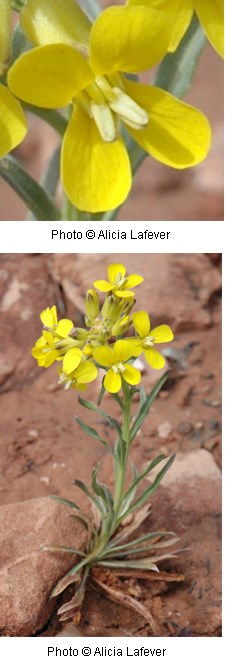
Erysimum asperum Family: Brassicaceae (A Utah Flora – Cruciferae) – Mustard Family Biennial or short-lived herbs; stems 4.7” to 3.3' (1.2 to 10 dm) tall or more Leaves: alternate or basal and still alternate; simple; basal leaves 0.8” to 4.8” (2 to 12 cm) long, 0.08” to 0.56” (2 to 14 mm) wide; upper leaves 0.44” to 4.16” (1.1 to 10.4 cm) long, 0.04” to 0.6” (1 to 15 mm) wide Flowers: 4 yellow petals in the shape of a cross or crucifer; 4 sepals; usually 6 stamens (with 2 outer shorter than the inner 4); 1 pistil; flowers in corymbs or racemes; usually radially symmetrical, sepals 4; petals 0.48” to 1.12” (12 to 28 mm) long; nectar glands commonly 4 Pollinators: other Erysimum species are pollinated by insects and hummingbirds Fruits: silique - a pod with 2 compartments with a thin partition Blooms in Arches National Park: March, April, May Habitat in Arches National Park: desert shrub and pinyon-juniper communities Location seen: upper Courthouse wash, Windows primitive trail, Windows road between Pothole Arch and Garden of Eden Other: The genus name, “Erysimum”, is from the Greek “eryomai” which means “to help or save” referring to the medicinal qualities of some species. The species name, “asperum”, means “rough”. Many plants in this family are weeds and they flower early because they are annual. Many vegetables are in this family– radish, cabbage, cauliflower. A few species of plants in this family are poisonous to livestock. |
Last updated: April 29, 2025
